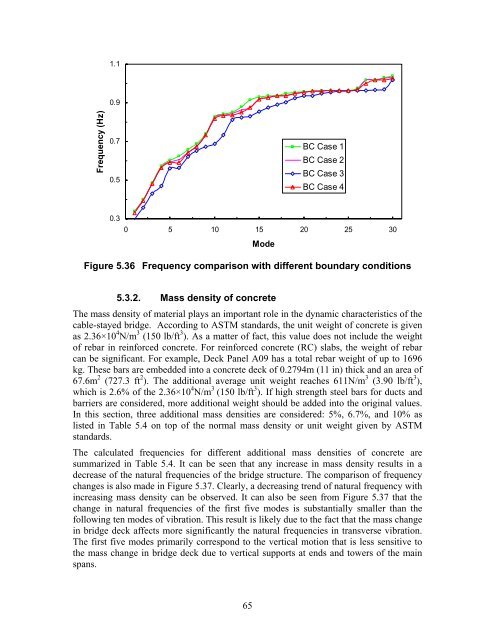Assessment of the Bill Emerson Memorial Bridge - FTP Directory ...
Assessment of the Bill Emerson Memorial Bridge - FTP Directory ...
Assessment of the Bill Emerson Memorial Bridge - FTP Directory ...
- No tags were found...
You also want an ePaper? Increase the reach of your titles
YUMPU automatically turns print PDFs into web optimized ePapers that Google loves.
1.1Frequency (Hz)0.90.70.5BC Case 1BC Case 2BC Case 3BC Case 40.30 5 10 15 20 25 30ModeFigure 5.36 Frequency comparison with different boundary conditions5.3.2. Mass density <strong>of</strong> concreteThe mass density <strong>of</strong> material plays an important role in <strong>the</strong> dynamic characteristics <strong>of</strong> <strong>the</strong>cable-stayed bridge. According to ASTM standards, <strong>the</strong> unit weight <strong>of</strong> concrete is givenas 2.36×10 4 N/m 3 (150 lb/ft 3 ). As a matter <strong>of</strong> fact, this value does not include <strong>the</strong> weight<strong>of</strong> rebar in reinforced concrete. For reinforced concrete (RC) slabs, <strong>the</strong> weight <strong>of</strong> rebarcan be significant. For example, Deck Panel A09 has a total rebar weight <strong>of</strong> up to 1696kg. These bars are embedded into a concrete deck <strong>of</strong> 0.2794m (11 in) thick and an area <strong>of</strong>67.6m 2 (727.3 ft 2 ). The additional average unit weight reaches 611N/m 3 (3.90 lb/ft 3 ),which is 2.6% <strong>of</strong> <strong>the</strong> 2.36×10 4 N/m 3 (150 lb/ft 3 ). If high strength steel bars for ducts andbarriers are considered, more additional weight should be added into <strong>the</strong> original values.In this section, three additional mass densities are considered: 5%, 6.7%, and 10% aslisted in Table 5.4 on top <strong>of</strong> <strong>the</strong> normal mass density or unit weight given by ASTMstandards.The calculated frequencies for different additional mass densities <strong>of</strong> concrete aresummarized in Table 5.4. It can be seen that any increase in mass density results in adecrease <strong>of</strong> <strong>the</strong> natural frequencies <strong>of</strong> <strong>the</strong> bridge structure. The comparison <strong>of</strong> frequencychanges is also made in Figure 5.37. Clearly, a decreasing trend <strong>of</strong> natural frequency withincreasing mass density can be observed. It can also be seen from Figure 5.37 that <strong>the</strong>change in natural frequencies <strong>of</strong> <strong>the</strong> first five modes is substantially smaller than <strong>the</strong>following ten modes <strong>of</strong> vibration. This result is likely due to <strong>the</strong> fact that <strong>the</strong> mass changein bridge deck affects more significantly <strong>the</strong> natural frequencies in transverse vibration.The first five modes primarily correspond to <strong>the</strong> vertical motion that is less sensitive to<strong>the</strong> mass change in bridge deck due to vertical supports at ends and towers <strong>of</strong> <strong>the</strong> mainspans.65
















